Hacking the Class Browser and Component
Gallery
Visual FoxPro's Class Browser and Component Gallery
(or just "Browser" and "Gallery") are valuable development tools;
most self-respecting VFP hacks will want to know them well.Most
of Visual FoxPro's ancillary tools, like Browser and Gallery, are
actually written in Visual FoxPro. (Surprised?) Starting with VFP
6, the source code for all the VFP-coded tools is included. This
is great news for VFP developers because the source for these
tools provides some great (and occasionally not so great)
examples. If you search carefully, you may even find an
astonishing feat of software prowess: a comment in the source
code. Lack of comments aside, if you've ever wondered just how a
particular wizard or service works, you can now easily and
legally reverse-engineer it. The source for VFP's tools is kept
in a ZIP file in the HOME()+"Tools\XSource" directory. If this
directory doesn't exist on your system, it's possible that you
chose to omit some tools during installation. The Browser and
Gallery source can be found in the HOME() +
"Tools\XSource\vfpsource\Browser" directory. The most interesting
file in this directory is the form Browser.SCX. The Browser and
the Gallery share the same SCX file, and many of the methods
therein serve both the Browser and the Gallery. Let's look first
at the Browser, and then we'll explore the Gallery.
The Class Browser
The Browser is useful for a
variety of development purposes. These include, among others:
- Managing classes and class libraries, including adding,
deleting, renaming and redefining classes.
- Generating equivalent code for visual classes.
- Creating running instances at design-time.
- Browsing all the classes and libraries used by a
project.
- Browsing the interfaces of ActiveX and COM components.
Starting the Class Browser
There are three ways
to start the Browser. From the Tools menu, select Class Browser.
Another way is to use the _BROWSER system variable. _BROWSER
defaults to "Browser.APP", which is located in the Visual FoxPro
home directory. Issuing the command:
DO (_BROWSER)
is equivalent to using the menu. In addition, you can pass a
parameter containing the name of the class library to load. For
example, this code:
DO (_BROWSER) WITH HOME(2)+"tastrade\libs\about"
loads About.VCX from the TASTRADE sample application. Add a
second parameter to the command to select a particular class in the
list. For example, this code:
DO (_BROWSER) WITH HOME(2)+"tastrade\libs\about", "aboutbox"
loads the About library and selects the class called
AboutBox. Specifying a form file name directly works, too:
DO (_BROWSER) WITH HOME(2)+"tastrade\forms\customer.scx"
starts the Browser with the form Customer.SCX loaded.
Finally, if the Gallery is running, you can just click the Browser
button to show the Browser.
The Browser Interface
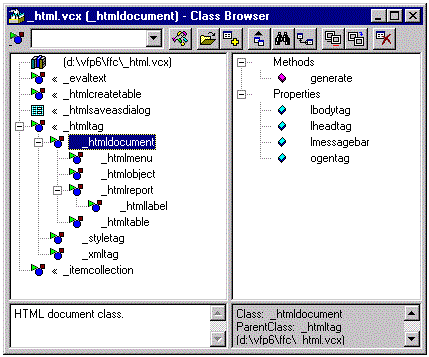
Figure 5-5: Just browsing, thanks. The Class
Browser interface.
Figure 5-5 shows the Browser. Here are a
few things you should know about the Browser to increase your
productivity with this tool.
|

|
Click this button to see the class code. Note that in
some cases, the code shown can't be executed correctly.
(This happens if the class is a container of other
classes.) Right-click this button and see the class code in
HTML format. This isn't obvious, but the window that
appears is actually an instance of your HTML browser. You
can right-click in the window and choose View Source to
display the HTML source for the display.
|
|

|
Use this button to create a new class. This new class
can be a subclass of the currently selected class, a
subclass of any other class, or a subclass of a VFP base
class.
|
|

|
You can redefine classes (that is, change the parent
class) in the Browser with this icon. Starting in VFP 6,
you can even redefine a class to use a different base
class, after being warned that some intrinsic methods and
properties will understandably be lost in the process.
|
|

|
When you have a method code window open, this button
(which floats or docks independently of the Browser on a
one-button toolbar) allows you to view the code up the
class hierarchy in parent class methods. This button is
available even after you close the Class Browser.
|
View More Than Class Libraries
In the Browser's
Open dialog, note the different types of files that are
supported. Figure 5-6 shows the Browser's Open dialog with the
drop-down expanded to show the sorts of things you can display in
the Browser.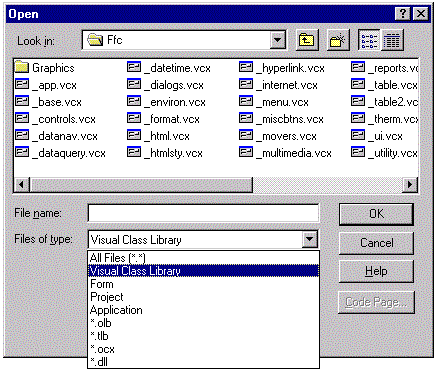
Figure 5-6: Open sesame! The Class Browser's Open
dialog shows that you can view more than just class libraries in
the "Class" Browser.
You can open VFP forms in the Browser;
many of the features, such as showing code, work as you might
expect. This is very handy for communicating your code examples
with other users via e-mail. If you open a VFP project file, all
the class libraries in that project are visible in a single view.
This is great if your project contains hundreds of classes and
you have no idea which library a particular class belongs to.
This view is a lifesaver when you inherit (or join) a new
project.You can open all manner of EXE and OLE files, and the
Browser displays their public interfaces. If help is available,
double-clicking an item or pressing the spacebar invokes it.
Clever Tricks
To add controls to a form or
class, in the Browser open the VCX
(class library) containing the class of the object you want to
add to the form, select the class, and then drag and drop the
class icon to the design surface. You can also drop a control on
the desktop, and you'll get a running instance of that class.To
quickly get to a class you're using, in the Form or Class
Designer select an object. Open the Browser. It opens with the
class library of the selected class loaded, and with the selected
class highlighted.
Class Management
Table 5-1 shows what you can do
with classes using either VFP commands or the Browser.
Table 5-1: The class-management functions of the
Class Browser.
|
Action
|
VFP Command
|
Class Browser Action
|
|
Clean up a class library
|
COMPILE CLASSLIB or open the VCX as a table and issue a
PACK command.
|
Highlight a class or class library file in the Browser
and click the Clean Up Class Library button.
|
|
Copy a class from one class library to another
|
ADD CLASS
|
Open two copies of the Browser, with one pointing to the
class to be copied and the other containing the destination
class library. Ctrl+drag the class's icon from one Browser
instance to another.
|
|
Create a class library
|
CREATE CLASSLIB or CREATE CLASS using a new class
library.
|
Click the New Class icon and specify the new class
library name in the New Class dialog.
|
|
Create a new class
|
CREATE CLASS
|
Select the parent class in the Browser and click the New
Class button.
|
|
Move a class between class libraries
|
No single command exists to move a class. Instead, copy
the class to a second library (ADD CLASS), and then remove
it from the first.
|
Drag the class's icon from one Browser instance to
another. If subclasses of the moved class are open in any
open Browser instances, the subclasses are automatically
remapped to the parent class's new class library. If
subclasses of the moved classes aren't open in another
Class Browser instance, you've just corrupted your class
hierarchy. Watch out!
|
|
Open a class in the Class Designer
|
MODIFY CLASS
|
Select the class in the class library. Then double-click
it, select Modify from the shortcut menu, or press the
spacebar.
|
|
Remove a class from a class library
|
REMOVE CLASS
|
Select the class, and then select Remove from the
shortcut menu.
|
|
Rename a class
|
RENAME CLASS
VFP does not adjust classes below the renamed class in
the class hierarchy.
|
Select the class, and then select Rename from the
shortcut menu.
The Browser adjusts classes below the renamed class in
the class hierarchy if they're displayed in any open
Browser window (not just the current one).
|
|
View class code
|
There's no command or series of commands to do this,
short of a complex program.
|
Select the class and click the View Class Code
button.
|
|
Add an instance of a class to a container (such as a
form or _SCREEN)
|
Container.AddObject() or Container.NewObject()
|
Click on the Move icon (the top-left icon in the Browser
form, which changes based on the highlighted item) and drag
it to the container.
|
|
Change the icon for a class
|
There's no command for this. Instead, open the class in
the Class Designer, choose Class Info from the Class menu,
and change the Container Icon setting.
|
Right-click on the Move icon and select an image file in
the GETPICT() dialog that appears. There's a nice touch
here: When you select Cancel in the dialog, you get the
option to reset the icon to the default for that item.
|
Programming the Class Browser with Add-Ins
The
VFP Browser is designed for extensibility. It has a rich
programming interface, and it exposes its complete object model.
The usual way to program the Browser is by hooking its events and
methods with Browser add-ins. An add-in is a program that you
create (or download) and then register with the Browser. Once
registered, the add-in can be invoked automatically by Browser
events or methods. If the add-in is not assigned to a particular
event or method, the user can invoke it.Here is an example
Browser add-in that demonstrates some of the most important
qualities of add-ins.
* Program Add-InSample1.PRG
* This program echoes class information to
* the debug output window
#DEFINE DEBUGWINDOW "Debug Output"
LPARAMETERS oBrowser
IF ! oBrowser.lFileMode AND !EMPTY(oBrowser.cClass)
ACTIVATE WINDOW DEBUGWINDOW
*-- Output the class name
DEBUGOUT "Class Name: "+ oBrowser.cClass
*-- Output the class library name
DEBUGOUT "Class Library: "+ oBrowser.cFileName
*-- Output the class's timestamp
DEBUGOUT "Timestamp: "+ PADR(oBrowser.nTimeStamp,25)
*-- Display the entire class pedigree
DO WHILE oBrowser.SeekParentClass()
*-- Output the parentclass name
DEBUGOUT "Parent Class: "+ oBrowser.cClass
ENDDO
ELSE
WAIT WINDOW "Please select a class and try again"
ENDIF
Observe the following points about the sample add-in above:
The Browser passes a reference to itself as a parameter to the
add-in. This means that all of the Browser's members are available
for reference. The example demonstrates the Browser's cClass,
cFileName, and nTimeStamp properties, and its SeekParentClass
method. Now, with the Browser running, register the add-in as
follows:
_oBrowser.AddIn("Sample Add-In", "Add-InSample1.PRG")
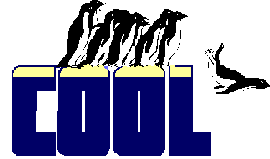 |
While the Browser form is running, you can refer to it
with a memory variable named _oBrowser.
|
The Browser's AddIn method registers add-ins. The syntax shown
here specifies a name for the add-in and the program to run. An
optional third parameter specifies the event or method to which
the add-in gets assigned.If a Browser event is assigned to the
add-in, then the add-in is invoked automatically near the
beginning of that event's execution. If a Browser method is
assigned to the add-in, then the add-in is invoked near the end
of that method's execution.In the example above, since no method
or event is specified, the add-in is listed in the Browser's
add-in shortcut menu.
 |
The Add-In option doesn't always appear on the shortcut
menu. When the mouse is over the Classes or Members panes,
right-clicks don't show add-ins among the choices. You have
to right-click on either of the description pages or the
top of the Browser, where the buttons are, or over the
Browser form itself, to see the add-in item.
|
Alternately, passing the name of an add-in to the Browser's
DoAddIn() method runs that add-in.
Tell me more! Tell me more!
The Browser is
extensively documented under "Class Browser" in VFP Help. Also
take a look at the following topics: "Class Browser Buttons",
"Class Browser Methods", and "Class Browser Properties." For more
information on add-ins, see also the white papers section of the
Visual FoxPro pages on the Microsoft Web site.
Having Trouble with the Class Browser's ActiveX
Controls
Some people complain that earlier versions of the
Class Browser crashed a lot. Although that's not much of an issue
in later versions, if the Browser is prone to instability on your
system, try invoking it with the optional third parameter set to
.T.:
DO (_BROWSER) WITH FileName, , .T.
This opens the Browser in "listbox" mode with the TreeView
control replaced by a VFP listbox. It's not as pretty looking, but
it may work better for you. (This is a legacy feature from VFP 3,
which had a Mac version; the listbox is a substitute for the
outline OLE control, which doesn't have a Mac counterpart.)
The VFP Component Gallery
The Gallery is the
Browser's companion. Both share the same display surface, and you
can toggle between them with a handy command button. The Gallery
is a flexible and programmable shortcut manager. Because it works
with shortcuts, you can't hose a file using the Gallery; when you
delete a shortcut from the Gallery, the underlying file is not
deleted. The Gallery can be used to categorize and display almost
anything, and its strength is in grouping the various resources
used in software development. With the Gallery, you can create
and display your own abstractions, organized as you wish, with
event behavior—such as click, right-click, double-click—that you
can innovate and control. Moreover, the Gallery also has
dynamic folders, which we'll discuss in a minute, which
have the ability to hold all the contents of VFP projects, class
libraries and directories.Now, you could use the Other Files
section of the Other tab in Project Manager to do some of this,
but that's primitive, inflexible, and—let's face it—low tech.
What's What in the Gallery
It's probably a good
idea to explain a few things before going further.A
catalog is both a DBF table and the highest-level element
of the Gallery. A catalog's records define the shortcut items you
see in the right-hand pane in the Gallery.A folder is
simply a logical package of items and possibly other folders.
(Folders look just like subdirectories and that abstraction works
for us.) Folders are either static or dynamic. A
static folder contains predefined shortcuts to items. A dynamic
folder determines its contents each time the Gallery is
refreshed. A dynamic folder could be defined as a directory
("C:\Projects\*.*"), a VFP project, or a class library.An
item is a shortcut to a particular file or URL.An item
type defines the behavior of particular items in the catalog.
Item types are stored in the HOME()+"Gallery\VfpGlry.VCX" class
library, and are configurable through the Properties dialog for
each catalog. The root catalog, named "Catalogs", contains the
default item types that apply to all catalogs. See "Understanding
Item Types" below for more on item types.
Start Me Up!
VFP has a system memory variable
named _GALLERY to identify the Gallery application. By default,
it's called "Gallery.App" in your HOME() directory. You can
replace or "wrap" the Gallery application by changing the value
of _GALLERY. You can use the _GALLERY memory variable to invoke
the Gallery, like this:
DO (_GALLERY)
In addition, you can pass a parameter containing the name of
the catalog to load. For example, this code:
DO (_GALLERY) WITH HOME()+"Gallery\Vfp Catalog"
loads Vfp Catalog.DBF. You can also start the Gallery from
the Tools menu, or click the Gallery button in the Browser.
The Component Gallery Interface
If you're
comfortable with Explorer-type interfaces, the basic features of
the Gallery (shown in Figure 5-7) will work pretty much as you'd
expect. 
Figure 5-7: The Component Gallery interface—yet
another Explorer-type interface
The Gallery is segmented into
two panes. The Catalog pane, on the left, lists the folder
hierarchies within the currently open catalogs. The Items pane,
on the right, shows the items in the current catalog or folder.
Both panes are endowed with item-sensitive context menus to do
the usual useful things such as cut, copy, paste, rename, and so
on. You can also invoke item-sensitive property dialogs for
selections in the left or right panes. Moreover, the entire
Gallery is enabled for both regular and OLE drag and drop.As in
the Browser, the Move icon—the top-left icon in the Gallery form
(which changes based on the highlighted item)—can be used to drag
the currently selected item to the desktop, a design surface, or
a project. Right-clicking the Move icon invokes a GETPICT()
dialog to change the icon. There's a nice touch here: When you
select Cancel in the dialog, you get the option to reset the icon
to the default for that item.The View Type drop-down lets you
choose among different views of the Gallery. For example, in the
VFP Catalog, selecting "Internet" filters the catalogs to display
Internet items only. To create your own custom views, use the
Dynamic Views tab in the Gallery Options dialog—we'll look at
that in more detail a little farther along. The Browser button
toggles the view back to the standard Browser. Neat touch here:
Right-clicking the Browser button brings up a nice long list of
the previously opened folders.The Open button is for opening new
catalogs. The Open dialog (Figure 5-8) is a little unconventional
and merits explanation. In the process, we'll take our first look
at the Gallery internals.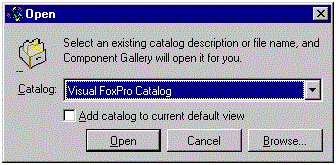
Figure 5-8: An Open dialog like no other. The
Component Gallery's Open dialog is different because it offers
catalog tables, and those references are kept in
Browser.DBF.
This isn't your garden-variety Open dialog. The
catalog drop-down control displays the catalogs currently
registered on your system. The catalog names are kept in the
Browser.DBF table. If you ever clean out or lose Browser.DBF, you
can click the Browse button to select an existing catalog file
that isn't listed in the Catalog drop-down. The "Add catalog"
check box control adds the contents of the catalog to the current
view (the default is to close the current catalog and open the
one you specify).The Options button brings you to a three-tabbed
dialog (Figure 5-9) where you can set certain Gallery
properties.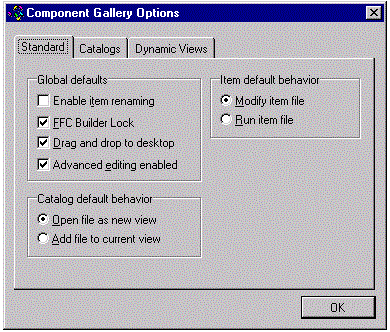
Figure 5-9: I need options. The Component Gallery
comes with its own options; this figure shows the Standard
tab.
The Standard tab displays the general defaults for the
Gallery itself. Like some of the Tools | Options dialog options,
these brief labels can be pretty obscure until you understand the
product well:
- The "Enable item renaming" check box determines if clicking
and then hovering over the item puts you in a name-edit mode,
just as it works in Explorer.
- The "FFC Builder Lock" check box will, if checked,
automatically invoke builders for new objects you create with
the Gallery. If they have a builder, that is. Some do, some
don't.
- The "Drag and drop to desktop" check box enables dragging
and dropping to the desktop, just like it works in the Class
Browser.
- Checking the "Advanced editing enabled" check box gives you
access to advanced features of Gallery property dialogs. This
is where the Gallery really starts to shine!
 |
The "Advanced editing enabled" check box is a killer. If
this option isn't checked, that explains why you can't do
half the stuff we're talking about in this chapter.
|
- The "Catalog default behavior" option determines whether
new catalogs are appended to, or replace, the current visible
collection of catalogs.
- The "Item default behavior" option determines whether
double-clicking on an item opens or edits an item by default.
This applies only to items that can be edited in VFP, of
course. Otherwise, the selection will simply run regardless of
what you've specified here.
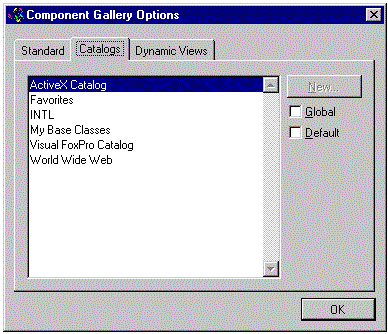
Figure 5-10: What, no underwear ads? A catalog page
suitable for family viewing.
Use the Catalogs tab (Figure
5-10) to maintain the list of catalogs that appear in the Catalog
drop-down in the Catalog Open dialog.
 |
The New button is enabled only when at least one catalog
is loaded in the Catalogs pane. We don't know why we need
to load a catalog before we can create a new one, and
frankly this behavior seems wrong. Nonetheless, that's the
way it is.
|
The Global and Default check boxes let you set the persistent
visibility of each catalog. A Global catalog is always visible in
the Catalogs pane, regardless of which catalogs you open for
display. You may want to mark the Favorites catalog as a global
catalog so you always have access to your favorite things. A
Default catalog is the one that's active and current whenever the
Gallery is invoked programmatically. You can have any number of
default catalogs.
 |
When you invoke the Gallery from the Browser, it always
comes up empty. The only way the Gallery appears initially
populated with the default catalogs is when it's originally
opened with DO (_Gallery) or with Tools | Component
Gallery.
|
The Dynamic Views tab lets you create your own custom, live views
of your catalogs. Figures 5-11 and 5-12 show how to create or
edit a new dynamic view called "Excel Spreadsheets" that displays
all items of type "file" that contain ".XLS" in their names.
 |
We think dynamic views are ultra cool. This adds a
second powerful dimension to the Gallery. The first
dimension is the obvious one: catalogs and folders that
logically segment things as you choose. But dynamic views
permit you to see all the items of a particular type (you
define), regardless of their logical placement within a
catalog.
|
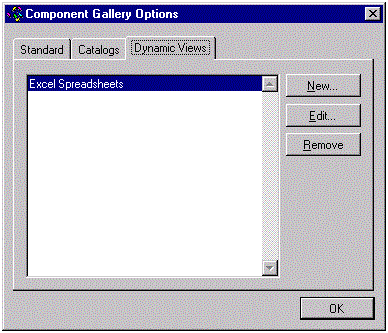 Figure 5-11
Click the New button to create a new view, or the Edit button to
bring up the dialog below.
Figure 5-11
Click the New button to create a new view, or the Edit button to
bring up the dialog below.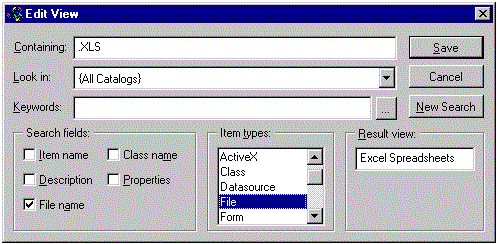
Figure 5-12: A different view of things. This is
where you define and edit dynamic views.
Figure 5-13 shows the
Keywords dialog, accessible from a button in the Edit View
dialog. This dialog lets us create dynamic views based on
keywords used to describe them. The keywords displayed in this
list are stored in a table called Keywords.DBF. You can use
keywords to further expand the power of the Gallery's dynamic
views.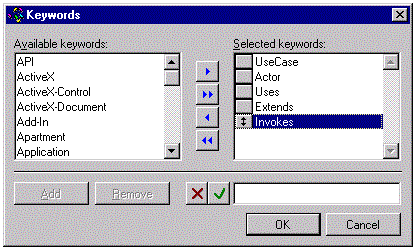
Figure 5-13: Views can be based on keywords you
specify.
 |
In order to add a keyword, you must first have a catalog
loaded in the Gallery. When we instructed the underpaid
workers at Hacker Laboratories to take the screen shot
shown in Figure 5-13, we forgot to mention that, so that's
why the Add and Remove buttons look disabled.
|
 |
We think all the things you can do in the Options dialog
are a good idea. But we cannot fathom why the Catalogs page
is in that dialog. More specifically, we can't understand
why the New button is in that dialog. This isn't an option,
it's an action. Options are choices you make about how
things look or operate. It's as if the New button in the
Project Manager could only be accessed from the Project
Info dialog. We'd feel the same way about the Dynamic Views
page, except for one thing.
Surprise! The Find button works just like choosing New
on the Dynamic Views page! In effect, when you choose Find,
you create a new persistent view. We're not really crazy
about this; after all, cluttering our dynamic views every
time we go searching is a bit much. However, it's easy
enough to clean up the list of dynamic views using the
Dynamic Views page.
|
Understanding Item Types
So, how does the
Gallery work internally, you ask?The behavior of a Gallery item,
like what happens when you click or drag it, is defined by its
item type. The class library Gallery\VfpGlry.VCX stores the item
types supplied by Microsoft, and you can modify, subclass, or
simply copy these classes to create your own types. If you
develop your own custom item types, it's probably a good idea to
store them in some other VCX, such as My_VfpGlry.VCX. This
allows you to later update the Gallery's class libraries without
fear of clobbering your work.Here's the hierarchy of the Gallery
item types as supplied by Microsoft. The _item and _folder
classes live in _Gallery.VCX. All other classes are defined in
VfpGlry.VCX.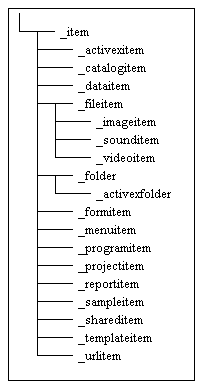
Figure 5-14: Type-o-rama! The Item Types hierarchy
provided by Microsoft.
When creating your own item types, the
most flexible base type is the _fileitem. In fact, _fileitem
should serve most of your needs because its behavior is to simply
invoke the Windows file associations. Moreover, the _fileitem
type has the ability to redirect popular file extensions to other
file types. We'll talk more about redirection in a minute.Item
types can be tied to particular catalogs. The root catalog, which
is always named "Catalog", serves as the basis for all catalogs.
If you select the Item Types tab of the properties of the root
catalog, you'll get something like the dialog in Figure 5-15 once
you've turned on the Advanced Editing option on the Class
Browser's option dialog. Do it now! C'mon, you're reading the
Hacker's Guide! That alone qualifies you as
"Advanced!"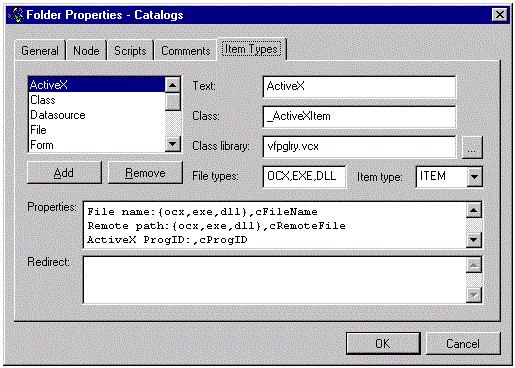
Figure 5-15: Catalog Properties, Item
Types.
Note the following things about the Item Types page in
this dialog:
- The list of item types matches the item types you see in
the New Item shortcut menu. To modify the New Item shortcut
menu, simply edit this list.
- Each item type can be associated with display text, a
class, and a class library. In this case the display text is
"ActiveX", the class is _ActiveXItem, and the class library is
VfpGlry.VCX.
- The lines in the Properties edit box specify what's
displayed in the final page of the item's Properties dialog.
For example, for the ActiveX item type pictured in Figure 5-15,
when you examine the properties of an ActiveX item in the
Component Gallery you'll see the following:
- File name: with an associated Open dialog initialized
with OCX, EXE, and DLL files, and the file name specified
will be stored in the item's cFileName property.
- Remote path: with an associated open dialog initialized
with OCX, EXE, and DLL files, and the file name specified
will be stored in the item's cRemoteFile property.
- Other lines in the edit box can't be seen in Figure
5-15. They include entries for Class, Class Library, Source
project and Associated file; these all work the same as
described above for the corresponding text box
entries.
- If you create your own item types, you make them available
by clicking the Add button and filling in the specifics of your
new item type.
The properties for the _fileitem item type are worth a look
because, in addition to showing custom properties, they show an
example of item redirection. See the Redirect field in Figure
5-16.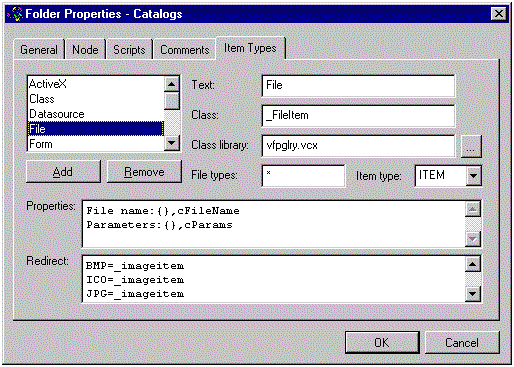
Figure 5-16: Item Types.
Here is the full list
of redirections:BMP=_imageitem, ICO=_imageitem, JPG=_imageitem,
GIF=_imageitem, WAV=_sounditem, RMI=_sounditem, AVI=_videoitem,
DBF=_dataitem, SCX=_formitem, MNX=_menuitem, FRX=_reportitem,
LBX=_reportitem, PRG=_programitem, APP=_sampleitem,
OCX=_activexitem, HTM=_urlitem, HTML=_urlitem, PJX=_projectitem,
TXT=_programitem, LOG=_programitem, H=_programitem.You can
probably guess how redirections work: When an item with any of
those file extensions is created, the designated item type is
created instead. For example, if you try to add a PRG as a file
item, the Gallery notices the PRG redirection and creates a
_programitem instead of a _fileitem. This is why the _fileitem
item type is so flexible; it has the ability to properly redirect
new items to the correct item type.
 |
Note that dragging VCX or PJX files from Windows
Explorer just creates a regular file shortcut, and not a
dynamic folder. We think VFP's Gallery should be able to
recognize VFP's own components.
|
Programming the Component Gallery with
Add-Ins
Since the Gallery and Browser are really the same
application, you can hook into the Gallery's events and methods
with add-ins in the same way you can with the Browser.
I Never Metadata I Didn't Like
Here's a brief
description of the data structures used by the Browser and the
Gallery.
Browser.DBF
The Browser stores all its metadata
in a table named Browser.DBF found in the VFP home directory. The
Gallery also uses Browser.DBF to store its catalog-related
information. Table 5-2 shows a field-by-field description of
Browser.DBF.
Table 5-2: The structure of Browser.DBF.
|
Field
|
Description
|
Used by (B)rowser
(G)allery
|
|
PLATFORM
|
"WINDOWS" or blank when Type="ADDIN". We suspect this is
left over from the VFP 3 days when there was something
other than Windows, and that it was retained for backward
compatibility.
|
BG
|
|
TYPE
|
Records with type field value "PREFW" store Browser and
Gallery preferences. Records with type field value "ADDIN"
store add-in information.
|
BG
|
|
ID
|
"FORMINFO" records are used by the Browser to store form
preferences and by the Gallery to store information about
your catalogs. The only way to tell the difference is that
Gallery records contain the string ".dbf" in the Name
field.
"BROWSER" records contain default settings for the
Gallery (not the Browser!). See the Properties field for
this record to see these default properties. These get set
in the Gallery Options dialog.
"METHOD" records store Browser add-ins that are tied to
a particular Browser event or method.
"MENU" records store Browser add-ins that are not tied
to a particular Browser event or method, and are thus
available on the Add-ins shortcut menu.
|
BG
|
|
DEFAULT
|
True for the default Gallery catalog.
|
G
|
|
GLOBAL
|
Applies to Gallery catalog records. True if the catalog
is global. By default, new catalogs are not global. To make
a catalog global, check the appropriate check box in the
Catalogs tab in the Gallery's Options dialog.
|
G
|
|
BACKUP
|
When Gallery opens a catalog or a VCX, this field in the
associated Browser.DBF record is queried. If the value is
True, the Gallery checks to see if a file of the same name
exists in the backup subfolder below that one. If the
backup file doesn't exist, it is automatically created (as
is a subfolder called Backup if needed). Then the Backup
field is set to .F. This field can be set programmatically
to force the Gallery to automatically back up a file the
next time—and only the next time—that file is opened. You
can set this field via add-in hooks, or with a program that
opens and updates Browser.DBF. Note that Gallery doesn't
automatically back up your work. You can force a backup at
any time by selecting Backup on the catalog item shortcut
menus.
This feature is used internally in one special case.
When Browser.DBF is first created after VFP is installed,
it's set up with the default catalogs (around five or so).
The Backup field is set to .T. so that each catalog gets
backed up the very first time it is opened, since VFP
doesn't install the associated backup catalog tables.
Beyond that special function, it can be used at will by
developers for their own purposes.
|
G
|
|
NAME
|
The file name that relates to this record. For a Browser
record, the file type could be, among other things, VCX,
PJX, SCX, OCX, DLL, EXE, or APP.
For Gallery records, the file type is DBF.
In the case of Browser and Gallery add-ins, the Name
field stores the name of the add-in. This is what appears
in the Add-ins shortcut menu if the add-in is not tied to
an event or method.
|
BG
|
|
DESC
|
Used only by the Gallery, it stores the description of
the catalog referred to in the Name field.
|
G
|
|
METHOD
|
Stores the name of the method to which an add-in is
tied. If the Method field equals "*", the add-in executes
for all methods.
|
BG
|
|
PROPERTIES
|
Used by the Browser to store default settings.
|
B
|
|
SCRIPT
|
According to our sources at Microsoft, this field is
used by code deep within the Gallery and is for internal
use only.
|
G
|
|
PROGRAM
|
Stores the name of the program to executein the case of
a PRG-based add-in.
|
BG
|
|
CLASSLIB
|
Stores the name of the class library in the case of a
VCX-based add-in.
|
BG
|
|
CLASSNAME
|
Stores the name of the class to execute in the case of a
VCX-based add-in.
|
BG
|
|
FILEFILTER
|
Used by add-in records to specify file masks for which
the add-in applies. The FileFilter is specified in the
fourth parameter of the AddIn method.
|
B
|
|
DISPMODE
|
Hierarchical/alphabetic listing display mode for the
Browser (numeric).
|
B
|
|
TOP
|
The stored top coordinate for the Browser/Gallery form.
All stored coordinates and sizes apply only if you include
the file name when you open the Browser/Gallery. When you
use the Open button, you get whatever settings are
currently in effect.
|
BG
|
|
LEFT
|
The stored left coordinate for the Browser/Gallery
form.
|
BG
|
|
HEIGHT
|
The stored height of the Browser/Gallery form.
|
BG
|
|
WIDTH
|
The stored width of the Browser/Gallery form.
|
BG
|
|
HEIGHT1
|
The stored height of the Class and Member description
panes in the Browser.
|
BG
|
|
WIDTH1
|
The stored width of the Class and Member description
panes in the Browser.
|
BG
|
|
HEIGHT2
|
The height of the Item Description pane in the
Gallery.
|
G
|
|
WIDTH2
|
The width of the Item Description pane in the
Gallery.
|
G
|
|
WINDOWSTAT
|
0—Window is zoomed normal; 1—Window is minimized;
2—Window is maximized.
|
BG
|
|
PROTECTED
|
True if protected members are to be displayed in the
right-hand Browser pane.
|
B
|
|
EMPTY
|
True if empty methods are to be displayed in the
right-hand Browser pane.
|
B
|
|
HIDDEN
|
True if hidden members are to be displayed in the
right-hand Browser pane.
|
B
|
|
DESCBOXES
|
True if description panels are to be displayed.
|
BG
|
|
AUTOEXPAND
|
True if hierarchical items are to be displayed
automatically expanded in the left-hand pane.
|
BG
|
|
PUSHPIN
|
True if the display is always on top.
|
BG
|
|
PCBROWSER
|
Parent class toolbar flag. If true for a file item, the
toolbar is on for that file. If you close the parent class
toolbar, this field is set to .F. for all open VCXs.
|
B
|
|
VIEWMODE
|
Indicates whether the Items pane of the Gallery displays
large icons, small icons, or a list.
|
G
|
|
FONTINFO
|
Stores the display font preference.
|
BG
|
|
FORMCOUNT
|
Used internally by the Browser to track the number of
Browser instances where this record's class library is
being displayed.
|
G
|
|
UPDATED
|
The datetime this record was last updated.
|
BG
|
|
COMMENT
|
A comment field for your use.
|
BG
|
|
USER1,2,3,4
|
Not used; there for your use.
|
BG
|
Additional Component Gallery Data
Structures
Here's a brief overview of Gallery-specific
structures. The Gallery distributes its metadata in several
locations.Like the Browser, the Gallery keeps some of its
metadata in Browser.DBF (described above). That data stores
references to the available catalogs, as well as some properties
such as whether the catalog is a global one (auto-open and always
in view) or default (in the default view). Delete a Gallery
catalog record from Browser.DBF and it won't appear in the
Gallery Open dialog. The Gallery catalog records in Browser.DBF
contain ".dbf" in their Name field. Since this field is of type
memo, you can't easily identify Gallery records in a simple
browse of Browser.DBF—what a pain.The rest of the Gallery
metadata is stored in VfpGlry.DBF, which lives in the Gallery
subdirectory below the VFP root. VfpGlry.DBF defines the default
display and behavior of the Gallery. When you look at the
Gallery, you are looking at catalogs whose items are defined in
the particular catalog tables, but whose default behavior
emanates from definitions in VfpGlry.DBF.In fact, delete all
Gallery records from Browser.DBF and the Gallery will
re-initialize the root catalog from data in VfpGlry.DBF.Many of
the records in VfpGlry.DBF point to behavior classes stored in
VfpGlry.VCX through fields named ClassLib and ClassName. Thus the
records in VfpGlry.DBF are pointers to the behavior classes that,
in the case of the native VFP-supplied behaviors, live in
VfpGlry.VCX. Of course, any custom gallery behavior you define or
modify can live in any VCX you choose. In fact, if you define
custom Gallery behavior classes or modify existing ones, we
suggest that you keep these in a different class library so that
future upgrades of VFP don't clobber your work.To illustrate some
of the functionality of VfpGlry.DBF, Table 5-3 examines some of
the fields in a representative record—the one with ID =
"fileitem".
Table 5-3: Some of the fields in VfpGlry.DBF for
the "fileitem" record.
|
Field
|
Value
|
Meaning
|
|
TYPE
|
"CLASS"
|
The Type field indicates what type of record this is.
You'll surely be stunned to find out that "FOLDER" types
are folders. The others aren't quite as obvious. "CLASS"
items define the metadata for the various types of things
the Gallery can display. "ITEM" types define the native
catalogs that ship with VFP. "OBJECT" types are objects
attached to the Gallery when it's instanced.
|
|
ID
|
"fileitem"
|
The unique identifier for this type of item.
|
|
TEXT
|
"File"
|
The item display text.
|
|
TYPEDESC
|
"ITEM"
|
This field, used only for records with TYPE = "CLASS",
indicates whether record represents a folder object or an
item object.
|
|
DESC
|
Text
|
The text appearing in the Item Description pane.
|
|
PROPERTIES
|
File name:{},cFileName
Parameters:{},cParams
|
Specification for input fields that appear in the
Properties dialog for items of this type. Values inside the
curly braces are used as the parameter in GETFILE()
dialogs.
|
|
CLASSLIB
|
Vfpglry.vcx
|
The class library where the item's behavior class is
stored.
|
|
CLASSNAME
|
_fileitem
|
The default class that embodies this catalog item.
|
|
ITEMTPDESC
|
BMP=_imageitem
ICO=_imageitem
JPG=_imageitem
GIF=_imageitem
WAV=_sounditem
RMI=_sounditem
AVI=_videoitem
DBF=_dataitem
SCX=_formitem
MNX=_menuitem
FRX=_reportitem
LBX=_reportitem
PRG=_programitem
APP=_sampleitem
OCX=_activexitem
HTM=_urlitem
HTML=_urlitem
PJX=_projectitem
TXT=_programitem
LOG=_programitem
H=_programitem
|
Alternate classes to use for file items of these
particular types.
|
Other records may use different fields and different values, but
this representative record is enough to get you started in
hacking the Gallery.Catalog tables contain records that reference
actual catalog items. The main native catalog is called "Visual
FoxPro Catalog" and is kept in "VFP Catalog.DBF." All VFP
foundation classes, for example, are cataloged there.The
structure of catalog tables is the same as that of VfpGlry.DBF,
so much of what we've already seen also applies here. This is a
good opportunity to look at a few other metadata fields and how
they work. Table 5-4 shows the record with ID = "clireg" in
"ActiveX Catalog.DBF." This item allows you to register a custom
VFP Automation server remotely using its generated VBR file.
Table 5-4: The "clireg" record in ActiveX
Catalog.DBF.
|
Field
|
Value
|
Meaning
|
|
TYPE
|
"ITEM"
|
This is an item, not a folder.
|
|
ID
|
"clireg"
|
This item's ID.
|
|
PARENT
|
"actxtools"
|
ID of the parent catalog record; in this case, it
corresponds to a folder named "Tools".
|
|
DESC
|
"This tool allows you to register a custom VFP
automation server remotely using the generated VBR
file."
|
The Description window text.
|
|
PROPERTIES
|
cDblClick=<>
|
You can override the events (KeyPress, Click, DblClick,
RightClick) by setting the c[EventName] property. If it's
something like cDblClick=DO Foo.PRG, then double-clicking
on the item in the Gallery runs that line. If you set
cDblClick=<testscript>, then double-clicking runs the
code in the Script memo field of the record with ID=
"testscript". If you set cDblClick=<>,
double-clicking runs the code in the Script memo field of
the current record.
In this case, DblClick runs the code in the Script field
below.
|
|
FILENAME
|
(HOME(6) + "CLIREG\CLIREG32.EXE")
|
The file name to execute when the item is
double-clicked. This value is stored in the oThis.cFileName
reference, which you can use in scripts. See the Script
field below. Note that the whole behavior of this item is
defined by the Filename field and, in this case, also the
Script field. The ClassName and ClassLib fields are blank
in this record.
|
|
SCRIPT
|
cVBRFile = GETFILE("VBR")
cCliReg = oThis.cFileName
IF !FILE(m.cCliReg)
RETURN .F.
ENDIF
IF EMPTY(m.cVBRFile) OR ;
UPPER(JUSTEXT(m.cVBRFile))#;
"VBR"
RETURN .F.
ENDIF
oThis.Runcode([RUN /N ] + ;
[&cCliReg. "&cVBRFile."] + ;
[ -NOLOGO])
|
The Script field gives you control over what happens
when the user runs the item. Here this scripting code will
run when the user double-clicks (see the Property field)
items of this type in the Gallery.
Note that, at present, there is no script equivalent of
DODEFAULT() so if you script an event, the default behavior
for that event will not execute.
|
Please Sir, I Want Some More
We've just
scratched the surface of the Browser and Gallery. If you're
interested in finding out more about these powerful and
extensible tools, we recommend Advanced Object Oriented
Programming With Visual FoxPro 6.0 by Markus Egger, also
available from Hentzenwerke Publishing (www.hentzenwerke.com).
Back to Table of Contents
Copyright © 2002-2018 by Tamar E. Granor,
Ted Roche, Doug Hennig, and Della Martin. Click for license
.
![]()
![]()
![]()
![]()









 Figure 5-11
Click the New button to create a new view, or the Edit button to
bring up the dialog below.
Figure 5-11
Click the New button to create a new view, or the Edit button to
bring up the dialog below.



